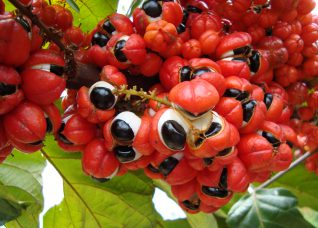
MinerAlert

MinerAlert
Paullinia cupana
Sapindaceae
Brazilian cocoa Guaraná paste, guaraná gum, chengrapi, macota.

This plant is a climbing evergreen liana or shrub that is native to Amazon region of South America, especially Venezuela and Brazil (Quattrocchi, 2012; Khan and Abourashed, 2010; Mabberley, 2008).
Seeds.
A paste is made from the seeds and consumed by some indigenous groups in the Amazon to reduce fatigue, as a diuretic, to reduce heat stress, and to treat diarrhea (Van Wyk and Wink, 2014; Khan and Abourashed, 2010 ).
Currently diverse beverages containing guaraná, from soft drinks (especially cola drinks or “sodas”), and chewing gum to “energy drinks” are available on the market. Aside from guaraná, some of these so-called “energy drinks” also contain varying amounts of caffeine (Schimpl, et al., 2013; Khan and Abourashed, 2010).
The seeds are used in ceremonial rituals, but they also have various health effects including: tonic, stimulant, aphrodisiac, nervine, anti-diarrheal, antipyretic (lower fevers), and astringent. The seeds are grated into water and used in traditional medicine for the treatment of menstrual problems, neuralgia, and headaches (Quattrocchi, 2012; Khan and Abourashed, 2010).
The seeds of the Guaraná shrub have the highest caffeine content (up to 6% in the seeds) among plants that contain methylxanthine compounds (Schimpl et al.,2014, 2013). The seeds or berries contain three to five times more caffeine than coffee but they also contains other compounds with antioxidant properties, such as epicatechins, catechins, and proanthocyanidins (Van Wyk and Wink, 2014; Khan and Abourashed, 2010).
According to Woods (2012), aside from the main constituent of guaraná (caffeine), the seeds also contain smaller amounts of theophylline and theobromine, but no evidence exists that the berries or seed extracts contain any other compounds that are useful for medicinal purposes. However, Schimpl, et al., (2013), mention that further studies need to be designed in order to assess the effects of guarana's other bioactive compounds and their potential pharmaceutical applications.
Schimpl et al (2014) studied the metabolism of caffeine and related stimulant compounds in the guaraná plant. The study also determined the levels of purine alkaloids in the tissues of five guaraná cultivars. The results showed that theobromine was the main alkaloid that accumulated in leaves, stems, inflorescences and pericarps (seed coats) of the berries, while caffeine accumulated in the seeds, with levels reaching from 3.3% to 5.8%. In all tissues analyzed, the alkaloid concentration, (theobromine and caffeine), was greater in young or immature tissues. As the plant matured, the levels of the alkaloids decreased.
Safety/Precautions:
Before you decide to take any medicinal herb or herbal supplement, be sure to consult with your health care professional first. Avoid self-diagnosis and self-medication: Always be on the safe side!